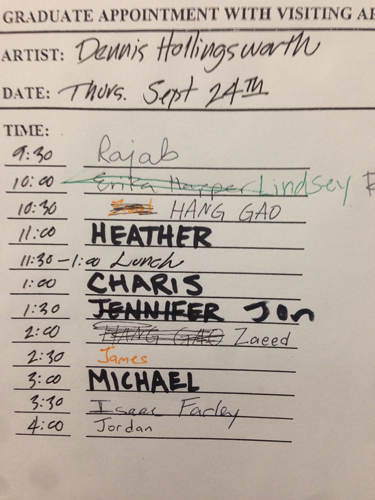October 28, 2015
The Grad School Crit

If you've scanned my Timeline Bio, you'll notice that I studied architecture in undergraduate school. My education was a plan I hatched when I was a sailor,. In the idealism of my youth, I wanted a solid foundation for the fine art graduate school that followed, and so it was. The transition between schools was dramatic. Architecture crits are usually large, public affairs. Since the agenda involves wrangling the various systems of architecture (structure, enclosure, procession, urban, environmental, etc.), there are a lot of objective criteria to probe and see if the student can orchestrate them all elegantly. Exactly how the student wrangles them all puts the critique into the subjective zone that we know as art. Usually, the student is required to convey a parti, much akin to the literary thesis, an expression of the design that should be both graphic and verbal. The number of architects and professors involved as judges can range between two to as many as ten and the best critiques become a clash between them, sometime agreeable and sometimes not and the student is left to sort out which streams of advice is best suited to their design. It's a huge public affair and the young neophyte architect develops a tough hide over the years of undergraduate education.
My entry into art school was a revelation. Art crits are private, solitary affairs. Professors and visiting artists are scheduled for one on one visits and the large group critiques are rare events that happen at the end of the term or shortly before graduation. They tend to wards the psychological and when a critique goes bad, they resemble psychological therapy. I figure that the reason for this tendency is that the realm of objective criteria in art is either small or hard to detect. In architecture, the design is usually found through an intersection of a Venn diagram involving the desires of the client, the city the design is situated, the environment, the realities of construction. The solution set is sought out in the intersection of these issues. Rarely is the vision of the designer is included in the Venn, and this is a problem in architectural education that the establishment is only dimly aware of. By contrast, art's Venn diagram begins with the vision of the artist, and what the art educational environment is dimly aware of is that an artist bubbles out their own matters in question, issues generated by the worldview of the artist. So as a result, art critiques can result in meandering probes, looking for anything to anchor onto, ranging from speculations of what the market might accept (horrible! no one knows this!), to what fits the current aesthetic paradigm (usually, the personal agenda of the critic, a sad projection), to dry mechanical solution sets regarding technique.
Well, I have my own method (the ultimate point of this post). It's a two part affair. First, I look for personal vision. Who are you? What are you all about? Second, I probe into their vista of art history.
Young artists usually imitate the art they like. It's an almost inevitable starting point. I forget now just who was the historical figure it was who said (it might be Gombrich) that to ascertain who you are, simply and strongly imitate the art you like and inevitably there will be differences. In those differences, there you are. It becomes difficult for the critique when the young artist is imitating in a several and vague manner, spotting the variables becomes tough work. The job gets tougher when the artist doesn't own up to their emulations.
In the best studio visits, the young artist shines out. Arenas of concern and fascination become indisputable. The project of critique becomes an effort to polish out anything that interferes with that gleam, and to reveal as best one can where else their path might lead.
Once we've established a datum of personal vision, I look for their understanding of art history. Yes, history is a flux of opinion but with time and distance, there are concatenations. I want them to be aware of history, to anticipate what their place is within the stream of history and have a strong attitude about it. We are living in a particularly difficult time because there exists a general and vague notion that we have come to the end of history. Recent periods of art history even toyed with the utopian idea that all that is possible today are footnotes and additions to the bibliography of what was once art history. My counter to that insidious impression is that if that were true, there would be no use for artists at all. The implicit premise of an art students existence is that they intend to be the authors of the next chapter of art history. So, I don't accept complacency in this regard. If a young artist is manifesting tropes of Pop Art, for example, I ask them what they think about that particular historical period and why it is yet relevant in our time. Was not Pop Art sufficient or is there more to say -TODAY- within its language? I must say that finding art students who have such a fix is rare. This is understandable. Matriculating through an education is a navigation through a blizzard of information. But as one approaches graduation, it is important to have created a intellectual compass by that time. It's important to have mentors who demand something more than complacency in oneself.
This assessment of art history together with the anticipation of the character of their vision gives me as a critic a basis to say anything halfway relevant concerning what they are making as artists. I want to be of service to them. Moreover, I visit art school studios with a quiet anticipation to be surprised and delighted. Challenged, even.
Posted by Dennis at October 28, 2015 4:00 PM
Leave a comment